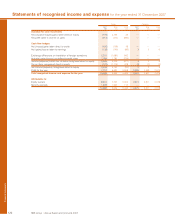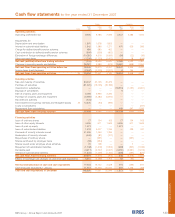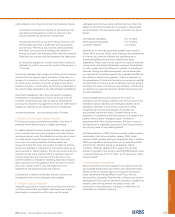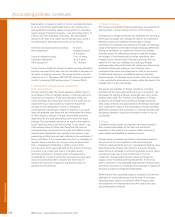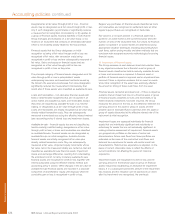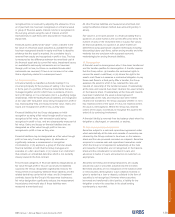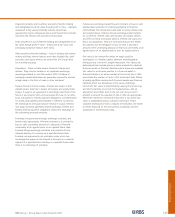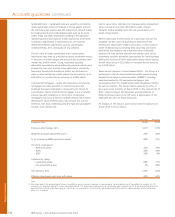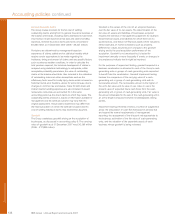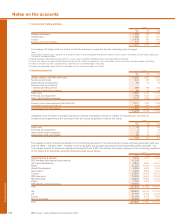RBS 2007 Annual Report Download - page 133
Download and view the complete annual report
Please find page 133 of the 2007 RBS annual report below. You can navigate through the pages in the report by either clicking on the pages listed below, or by using the keyword search tool below to find specific information within the annual report.
131
RBS Group • Annual Report and Accounts 2007
Financial statements
Hedge of net investment in a foreign operation – in the hedge
of a net investment in a foreign operation, the portion of
foreign exchange differences arising on the hedging
instrument determined to be an effective hedge is recognised
directly in equity. Any ineffective portion is recognised in profit
or loss. Non-derivative financial liabilities as well as derivatives
may be the hedging instrument in a net investment hedge.
20. Share-based payments
The Group grants options over shares in The Royal Bank of
Scotland Group plc to its employees under various share
option schemes. The Group has applied IFRS 2 ‘Share-based
Payment’ to grants under these schemes after 7 November
2002 that had not vested on 1 January 2005. The expense for
these transactions is measured based on the fair value on the
date the options are granted. The fair value is estimated using
valuation techniques which take into account the option’s
exercise price, its term, the risk-free interest rate and the
expected volatility of the market price of The Royal Bank of
Scotland Group plc’s shares. Vesting conditions are not taken
into account when measuring fair value, but are reflected by
adjusting the number of options included in the measurement
of the transaction such that the amount recognised reflects the
number that actually vest. The fair value is expensed on a
straight-line basis over the vesting period.
21. Investment property
Investment property comprises freehold and leasehold
properties that are held to earn rentals or for capital
appreciation or both. It is not depreciated but is stated at fair
value based on valuations by independent registered valuers.
Fair value is based on current prices for similar properties in
the same location and condition. Any gain or loss arising from
a change in fair value is recognised in profit or loss. Rental
income from investment property is recognised on a straight-
line basis over the term of the lease. Lease incentives granted
are recognised as an integral part of the total rental income.
22. Cash and cash equivalents
Cash and cash equivalents comprises cash and demand
deposits with banks together with short-term highly liquid
investments that are readily convertible to known amounts of
cash and subject to insignificant risk of change in value.
23. Shares in Group entities
The company’s investments in its subsidiaries are stated at
cost less any impairment.
Critical accounting policies and key sources of
estimation uncertainty
The reported results of the Group are sensitive to the
accounting policies, assumptions and estimates that underlie
the preparation of its financial statements. UK company law
and IFRS require the directors, in preparing the Group’s
financial statements, to select suitable accounting policies,
apply them consistently and make judgements and estimates
that are reasonable and prudent. In the absence of an
applicable standard or interpretation, IAS 8 ‘Accounting
Policies, Changes in Accounting Estimates and Errors’,
requires management to develop and apply an accounting
policy that results in relevant and reliable information in the
light of the requirements and guidance in IFRS dealing with
similar and related issues and the IASB’s Framework for the
Preparation and Presentation of Financial Statements.
The judgements and assumptions involved in the Group’s
accounting policies that are considered by the Board to be the
most important to the portrayal of its financial condition are
discussed below. The use of estimates, assumptions or models
that differ from those adopted by the Group would affect its
reported results.
Loan impairment provisions
The Group’s loan impairment provisions are established to
recognise incurred impairment losses in its portfolio of loans
classified as loans and receivables and carried at amortised
cost. A loan is impaired when there is objective evidence that
events since the loan was granted have affected expected
cash flows from the loan. The impairment loss is the difference
between the carrying value of the loan and the present value
of estimated future cash flows at the loan’s original effective
interest rate.
At 31 December 2007, gross loans and advances to
customers totalled £835,688 million (2006 – £470,826 million)
and customer loan impairment provisions amounted to £6,438
million (2006 – £3,933 million).
There are two components to the Group’s loan impairment
provisions: individual and collective.
Individual component – all impaired loans that exceed specific
thresholds are individually assessed for impairment.
Individually assessed loans principally comprise the Group’s
portfolio of commercial loans to medium and large businesses.
Impairment losses are recognised as the difference between
the carrying value of the loan and the discounted value of
management’s best estimate of future cash repayments and
proceeds from any security held. These estimates take into



